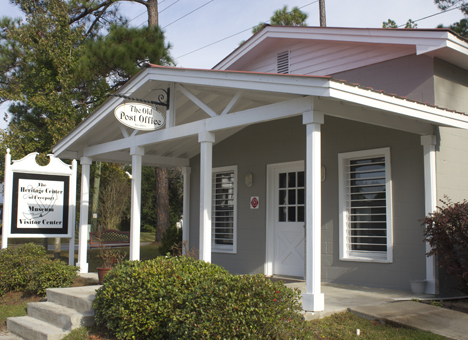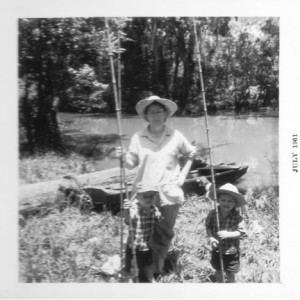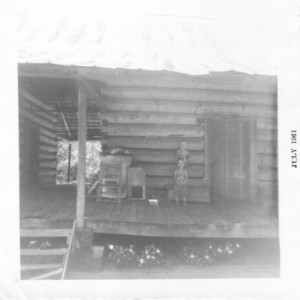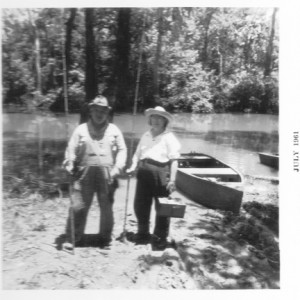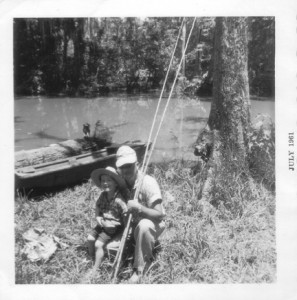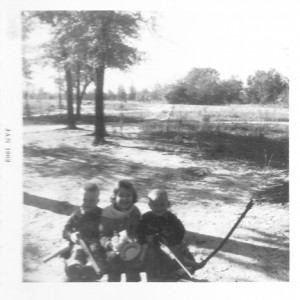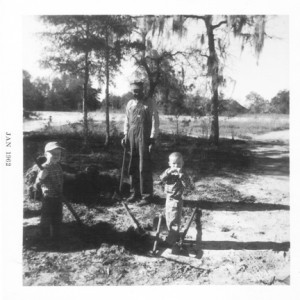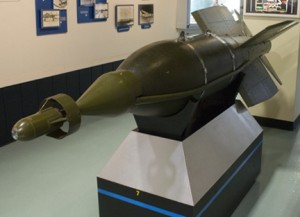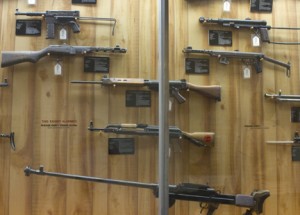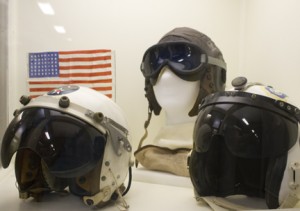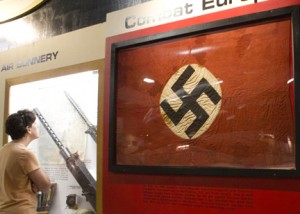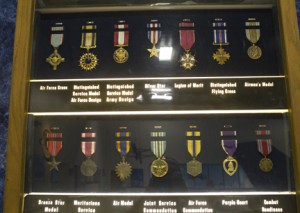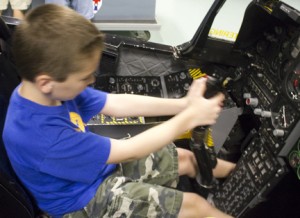Historical remembrances of the Choctawhatchee River
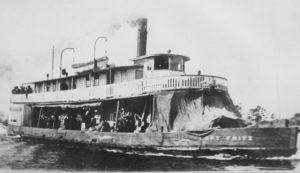
The following is a publication of interviews with the people who lived along the Choctawhatchee River done by Northwest Florida Water Management in 1988:
The Northwest Florida Water Management District (NWFWMD) made its first attempt at gathering oral accounts of life and resources us in northwest Florida. Ten “old timers,” each selected to represent an economic or subsistence activity common around the Choctawhatchee Bay during the early part o the 20th century, were interviewed and featured in a District publication. This publication, Historical Remembrances of the Choctawhatchee Bay, proved to be one of the most popular the District has produced. It was also a very useful publication in that it provided the District with insight into important conditions and attitudes concerning the bay. For example, the location of sea grass and oyster beds as they were 50 or 60 years ago, the earlier distribution of fresh and saltwater creatures, and first-person accounts of the origins of commercial fishing in the area all provided for a greater understanding of “natural” conditions in the bay while also allowing District to more fully comprehend local attitudes concerning water and wildlife resources. Click here to continue
Historical remembrances of the Choctawhatchee Bay
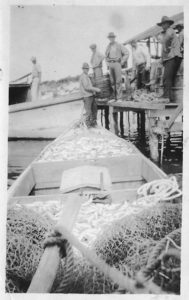
By James H. Cason, Robert A. Mills, and Paula A. Tully. Interviews by Tavia Copenhaver McCuen, with special assistance from Walter Francis Spence. A publication of Northwest Florida Water Management District, Dec. 1985
The mission of the Northwest Florida Water Management District is to implement the provisions of Chapter 373, Water Resources, Florida Statutes, in a manner that best ensures the continued welfare of the residents and water resources of Northwest Florida. Their core mission is to ensure a clean and adequate supply of water for the people and natural resources of the region; working to protect, maintain, and improve the quality of resources across the panhandle; promote flood protection through non-structural techniques; and protect and improve natural systems in Northwest Florida through land acquisition, management, and ecosystem restoration activities.
Northwest Florida Water Management District (District) has conducted several scientific studies of the Choctawhatchee Bay by investigating temperature changes, ground water conditions, oyster beds, submerged vegetation, the distribution and abundance of fish, and sedimentation. District engineers, hydrologists, geologists, and hydrogeologists conducted experiments and gathered information, synthesizing the data and drawing scientific conclusions.
Explore Freeport’s history at Heritage Center
The Heritage Center houses a museum on Freeport’s history and a visitor center.
“Freeport’s historian, Beckie Buxton, has been compiling stories and photos of Freeport for decades,” said curator Tim Ard. “Countless hours of volunteerism has created wonderful exhibits of Freeport’s families and businesses,” he continued.
The collection includes furniture from the McCaskill home, an icemaker from Casey Ice House, photographs, and additional items on loan from Freeport residents. The museum will be manned by a staff of volunteers, and open from 12 Noon – 5 p.m. Thurs. – Sat.
Freeport Heritage Center is located directly across from the Food Depot at 41 State Highway 20 East, Freeport. For more information, call Tim Ard at (850) 585-3304.
____________________________________________________________
Explore area history at the Heritage Museum in DeFuniak Springs
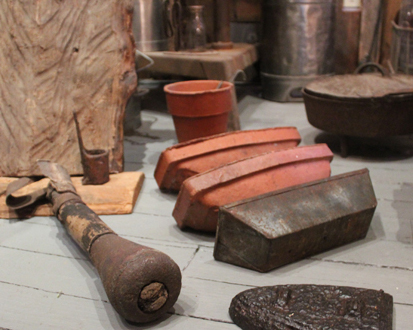
Interested in learning about Walton County’s history? Head over to the Heritage Museum in DeFuniak Springs and take a journey into the past.
Run by volunteers with the Walton County Heritage Association, the museum offers a peek into area history from 1885 – 1945. A variety of historical artifacts including arrowheads, old turpentine pottery shards, military information and more are on hand at the museum.
One of the highlights is a handmade 12 ft. x 17 ft. wool hook rug made by former first lady of Walton, Rubye Burton.
Known as the Lady of the Lake for her landscaping efforts along Lake DeFuniak, Burton was also the first female Gulf Oil distributor in the United States. Born in 1900, she lived to be 101.
Pick up a brochure and take a self-guided tour of the historic homes around Lake DeFuniak on Circle Drive. Interesting facts and historic information are in your hands as you take the scenic tour. You can also download a brochure by clicking here.
Located in the old L&N Railroad depot on Circle Drive, the museum is open Tues. – Sat. from 1 – 4 p.m. Admission is free. For more information, go to: http://www.waltoncountyheritage.org
1140 Circle Drive, DeFuniak Springs, FL 32435
Tel: (850) 951-2127
____________________________________________________________
Step into the past at the Washington County History Museum
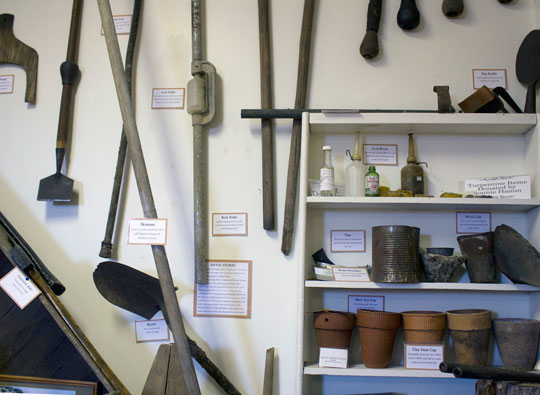
Washington County in the northwest Florida panhandle has a long and interesting history. Established in 1825, the area was first settled by those seeking both economic and political freedoms in a rough frontier land of vast timber and mineral resources. Inland waterway transportation on the Choctawhatchee River brought about river settlements, which later were named Ebro, Caryville, and Vernon along Holmes Creek. Vernon, the geographical center of the county, derived its name from George Washington’s Virginia home, Mt. Vernon. The pioneer town was also the site of a major Native American settlement. The County courthouse was located in Vernon during the early part of the 20th century until the railroad came into Chipley. Chipley became the new county seat in 1927.
Located in the center of downtown Chipley, the Washington County History Museum offers a tribute to the area’s history boasting relics of the past. The town square area, formerly the train depot, houses artifacts in two buildings, a caboose, gazebo, and green space.
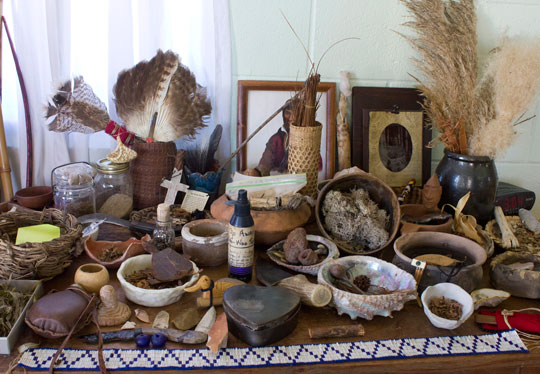
The main building houses an extensive turpentining exhibit with tools of the trade and collection pots used during its era. The first telephone service was implemented in 1896. The museum displays the history of the phone system in detail with relic switchboards, phones, and photographs.
Located next door to the main museum in the former Bill Lee train station is a vast collection of Native American artifacts. The exhibit features pottery, woven baskets, herbal medicines, furs, ceremonial instruments, weapons, and art. The collection is on loan from Debbie Bush of the Muscogee Creek Tribe, and features Creek artifacts from across the State of Florida.
The museums are open on Fridays from 10 a.m. to 2 p.m. If you are interested in joining the Washington County Historical Society, call 850-638-0358.
The History Museum is located at 685 7th Street, just north of Hwy. 90, in downtown Chipley. ::MAP::
For more information about Washington County click here.
____________________________________________________________
Step back in time at the Destin History and Fishing Museum
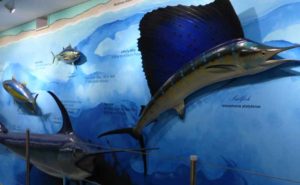
Most anyone who has been here for any length of time knows the best deep sea fishing in the Florida Panhandle is just offshore of Destin. You can learn how Destin got its name as the World’s Luckiest Fishing Village as you explore history and more at the Destin History and Fishing Museum.
The museum is chock full of noteworthy artifacts. Historical information dating back to the 1830s, along with environmental educational displays will entertain as well as educate visitors, and are just a few of the many fascinating exhibits. The 5,500 sq. ft. space also contains more than 75 life size mounted fish from the Gulf, and fishing history from as early as the Native Americans to modern times. A large portion of the museum also covers commercial fishing history, and an area dedicated to the annual Fishing Rodeo.
Exhibits in the outdoor Museum Historic Park complex include the historic seine boat ‘Primrose,’ mullet boat ‘Lil Jimmy,’ a seine net reel, and the original Post Office as well as a memorial walkway.
____________________________________________________________
A look back at Freeport’s former Bay Grove Motel and its owner Charlie Stiller
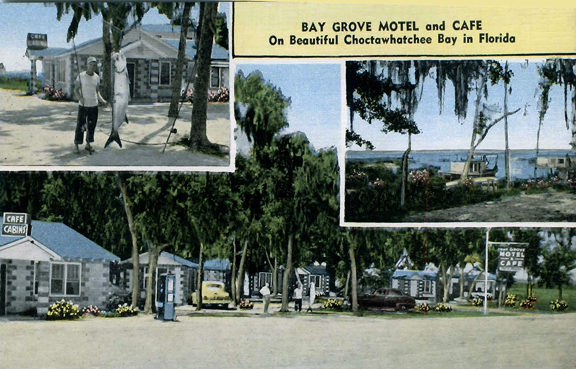
By Beckie Buxton, Freeport historian
Have you ever wondered about the Bay Grove Motel, restaurant and service station? Remnants of the buildings still remain at the northwest base of the Clyde B. Wells (Hwy. 331) bridge.
Freeport natives tell us that, until after World War II, and the building of the “331 Bridge,” a very large palmetto patch covered the parcel of land on the northwestern shore of the Choctawhatchee Bay.
The tourist industry was very small during the 1920s and 1930s. Poor roads and few bridges made it hard for visitors to access the area except by water.
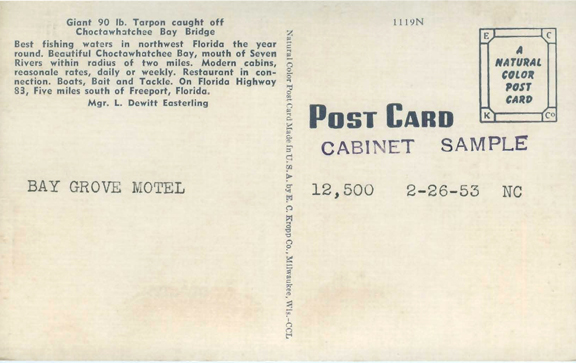
A man named Charlie David Stiller realized that the new Choctawhatchee Bay Bridge, and the end of rationing of fuel and tires, had greatly increased the number of travelers between Alabama and the Gulf beaches.
He bought that palmetto-covered property and developed it as a service station, café, and cottages to attract the trade of the travelers from Alabama.
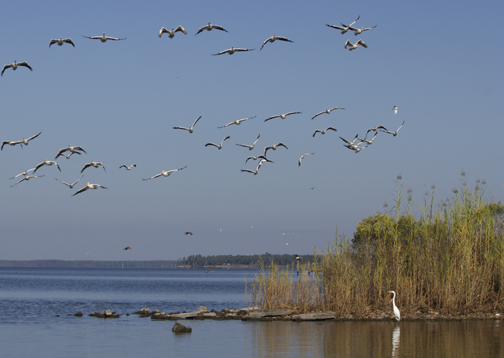
The café served very good seafood and was popular with locals as well. Teenagers enjoyed the hamburgers and made it a hang out.
In the 1950s, if a person liked to water ski, or enjoyed watching others water ski, the “bridge fill” adjoining Bay Grover was the place to park and visit on a Sunday afternoon. Soil for the causeway needed as an approach to the long bridge was dredged from the bottom of the bay. Hence the name of the area called “bridge fill,” although those who do not know its history sometimes call it the bridge “field” area.
There was land purchased with a plan to build a drive-in theater in the Bay Grover area at on time. It was advertised in the local newspapers.
Walton resident Patrick Pilcher remembers a boat marina with a bulk head area that accommodated large boats.
“The water was much deeper back then,” Pilcher recalled.
Although they continued to be viable until the 1970s, the once busy businesses of Bay Grove were sold and finally fell into disrepair.
Memories of it, however, will always include the dream of its developer, Charlie Stiller.
We know that Stiller was born in June of 1910 in Bruce, Walton County to Thomas E. Stiller and Lorna Stiller. His was Annie, was born about 19111 in North Carolina. Charlie’s siblings were Emma, Buford, L.V., Littie, and Daniel.
Prior to undertaking the Bay Grove complex, Charlie Stiller was already an industrious man. He had developed a lucrative pulpwood business, and had many employees in the area. At the time, the United States Deparment of Commerce assured that millions of tons of wood puplp would be needed in the years during and following World War II. As the need for pulpwood escalated, Stiller would sometines purchase a parcel of property, cut the timber from it, and then sell that property. He soon bought and sold enough land that he became active in Real Estate.
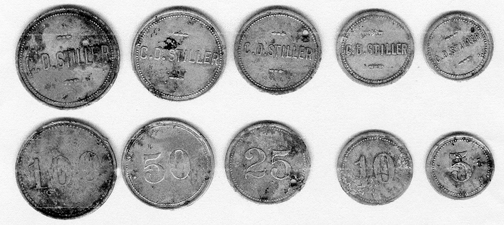
His employees would haul the stumps to Pensacola for extraction of tar and resins. In that way, he was also in the naval stores business.
Did you know:
– Resin is the sap that comes from a pine tree.
– A stiller was the person who made the pine resin into spirits of turpentine.
Charlie Stiller began paying his pulpwood employees with tokens and opened a grocery store and dance hall east of Freeport where his employees could pay for their groceries with the tokens.
For a good while lumbering (pulp wooding) and turpentine industries were successful, but declined as the source of trees became less. However, Charlie Stiller continued to be well known as a businessman in the area for years.
Charlie Stiller lived to the age of 78, and at the time of his death lived in DeFuniak Springs.
Learn more about Freeport’s history at the Heritage Center located on SR20.
____________________________________________________________
Area along the Choctawhatchee River boasts long history of outdoor recreation, logging
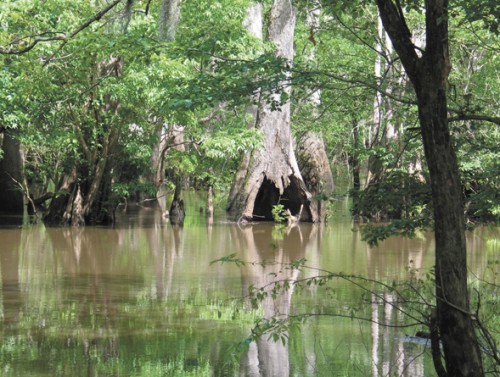
Former Walton County resident DeWayne Ray has fond memories of fishing and hunting around the Red Bay area of Walton County.
According to Ray, his ancestors the Chamberlains, Tiners and McDonalds spent time fishing and hunting at Lost Lake (now named Lost Lake at Tilley Landing) as far back as the 1830s. The family owned property where the old road began to the lake from Red Bay.
“My grandfather use to maintain the old logging road which crossed much of their property and lead to the Lost Lake. My ancestors fished, trapped and hunted this area since the 1830s,” said Ray.
“The landing area still appears has it did more than 50 years ago. My family and other local native Red Bay families fished the lakes on a regular basis, especially my grandmother and great aunt.”
Ray generously shared with Walton Outdoors photos taken in 1961 and 1962. The photos depict his family enjoying fishing and hunting along Lost Lake near the Choctawhatchee River.
“The small boys are me and my brother with my mother (Joan Stiller Ray), father (Walter Ray) and my grandparents (Nellie Chamberlain Stiller and Wayland Stiller).
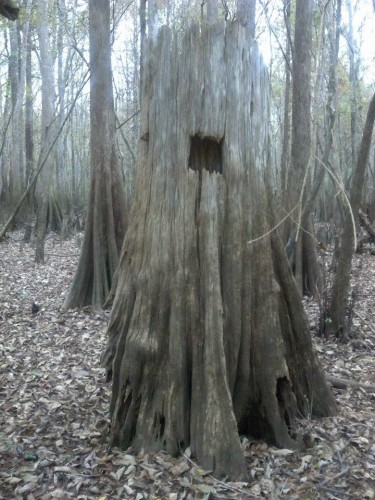
Walton Outdoors asked Ray about the old cypress trees in the area touting square cutouts. Ray contacted his father and this is his historical response:
“I spoke to my Dad, Walter Ray. The cuts in the cypress are likely either loggers were starting to ‘deaden the tree’ and immediately notice the trees were hollow and stopped the process. Only solid cypress were deadened, then harvested. Since “green” solid cypress would not float, the loggers would first “deaden” the tree by cutting a notch around the bottom of the tree, which would kill it over time, making the tree able to be floated out of the swamp to the main river for transport.
There is another reason cuts were made in the cypress, so loggers could insert boards to stand on while they cross-cut the tree down. Likely they noticed during this process the tree was hollow and stopped and moved on to solid cypress.
My Grandfather Stiller was born in a logging company train box car in 1906 and logged the Walton County area all of his life. When he was a very young man they still used oxen and cross-cut saws – way before tractors and power saws. As a result, his wrists were massive. You can tell where cross-cut saws were used by stumps being 2 or 3 feet above the grounds surface. There are a couple of these stumps on our property. There is one, now very decayed, in the Northwest Florida Water Water Manage swamp, near our property, that’s approximately 10-12 feet across! My Grandfather said they cut down this massive native pine and could not get it up the “bluff” with the oxen because the longs were just too heavy (circa 1920s). How I have wished that tree would have remained uncut,” Ray responded.
These days, Lost Lake at Tilley Landing is part of the Choctawhatchee River Wildlife Management Area, and is managed in cooperation with Northwest Florida Water Management District and Florida Fish and Wildlife Conservation Commission. It is open to fishing, hunting, boating, and primitive camping. It has picnic tables, pavilion, and a portable restroom facility. For information on hunting in the Wildlife Management Area, click here. For more information about Lost Lake, click here.
::map::
____________________________________________________________
Explore U.S. military history at the Air Force Armament Museum
Military buffs will delight in vast display of relics

Interested in learning about U.S. military history? Head over to the the Air Force Armament Museum at Eglin Air Force Base just north of Ft. Walton Beach. Military buffs of all ages will delight in the large display of aircraft, bombs, missiles and rockets spanning from WWI to present day.
Driving onto the grounds of the museum, visitors first notice an array of numerous aircraft surrounding the building. The fastest plane ever built, the SR-71 Blackbird is the centerpiece flanked by numerous planes from the Korean, Vietnam, and Gulf War eras.
Inside the museum are four aircraft as well as a wide variety of bombs, missiles and rockets. Several interactive exhibits entertain and educate. Hundreds of pieces of armament include a gun collection, bombs, bomblets and missiles including the Sparrow, Sidewinder, cluster bombs, Bunker Buster and the MOAB. A 32-minute film on the history of Eglin Air Force Base and its role in the development of armament is shown continuously throughout the day.
The Air Force Armament Museum is located on the Emerald Coast of the Florida Panhandle. It is on Highway 85 South, 7 miles north of Fort Walton Beach. The museum is open Monday through Saturday from 9:30 a.m. to 4:30 p.m. CST. It is closed on federal holidays. Tours are self-guided, admission is free.
No advance notice is necessary for groups; however, it is best to call ahead at (850) 882-4062 to insure there are no other functions occurring at the same time.
The museum is located at 100 Museum Drive, Eglin Air Force Base, Florida 32542. Learn more at http://afarmamentmuseum.com
____________________________________________________________
South Walton pioneer C.H. McGee known as Mr. Seagrove
By Carol McCrite
Note: This story was originally published in the historical book The Way We Were – Recollections of South Walton Pioneers by South Walton Three Arts Alliance. Republished with permission.
“Seagrove Beach – Where Nature Did Its Best.” C.H. McGee, Sr. (known to friends as McGee) coined the phrase to describe his personal feelings about the magnificent piece of gulf front land he purchased from J.R. Moody in 1949.
The 18-month campaign to acquire 160 acres of pristine beach in South Walton County became a monthly ritual for McGee and his son, Cube, as the drove to Mr. Moody’s Redhead, Florida farm, ate a wonderful home-cooked meal and “sat a spell.”
Then came the inevitable question: “Well, Mr. Moody, are you going to sell me Seagrove?” Predictably, the answer would always be, “Mr. McGee, let me think about it for a few days.”
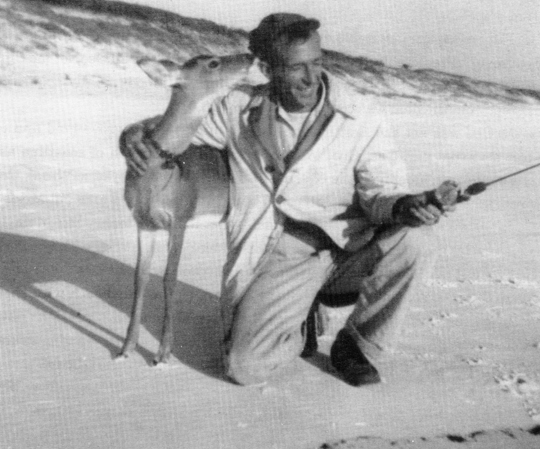
Persistence paid off when Mr. Moody finally acquiesced with, “Yep,” and the deal was consummated for $75,000.
McGee was not the first man to look from afar at Seagrove land and envision it a virtual paradise. Civil War sailors used this stretch of coastline as a navigational point, labeling it the Green Hill. The evident beauty of scrub oak trees growing to the edge of a 45-foot bluff could be seen for at least a mile out at sea.
Seagrove was so remote, and far removed, it took a visionary like McGee to appreciate what it could become. Cube recalls thinking, “this will be a lot of work,” but he believed his Dad was the man who could accomplish that feat. Click here to continue

